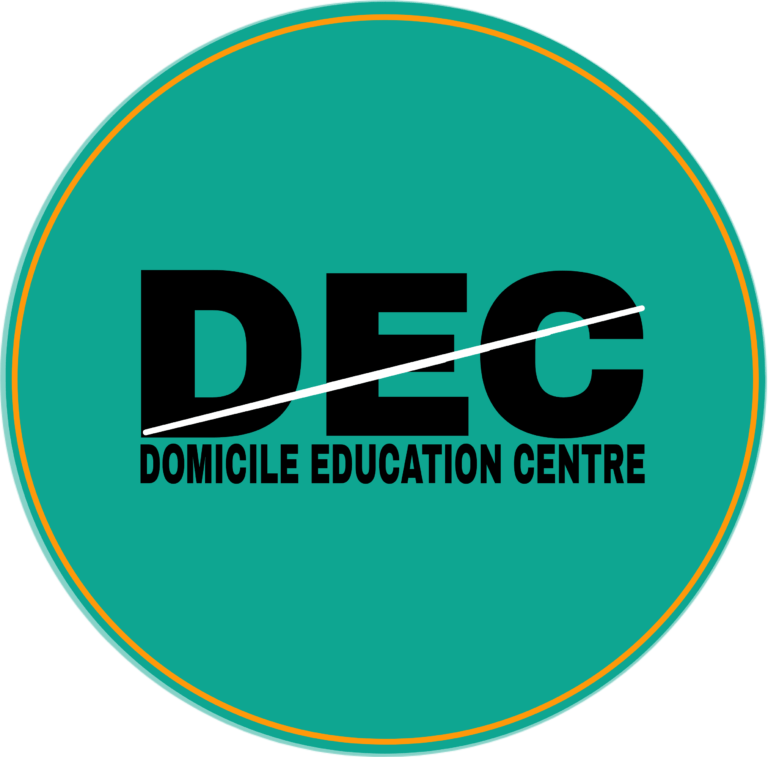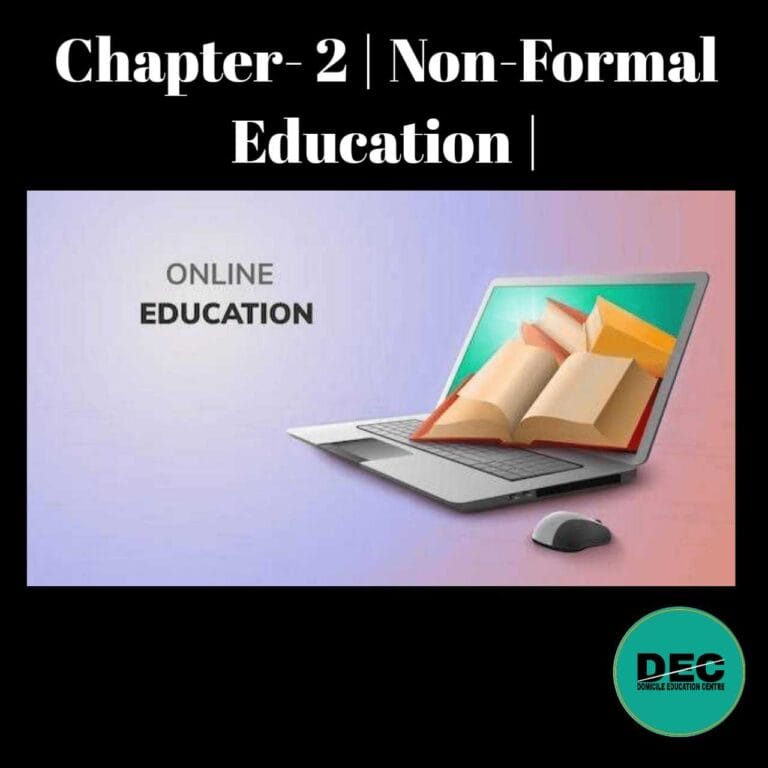Here You will get all questions answer related to the Chapter-2 Non-formal Education for Class-12.
Subject: Education
100%
Common
All previous Year Questions Answer included in all the chapters
Just Click Here: Class-12 Education Subject Notes PDF.
1. Explain the meaning of Non-formal Education?
Ans: Non –formal Education is one of the recent concept. This system of education is deliberate, conscious, organizes, systematic, need based and goal –oriented education. It is highly flexible and inexpensive. It provides functional education, life long education and also provides educational opportunities to late bloomer, dropouts and to the deprived classes. But now it intended for all.
2. What is Non-formal Education?
Ans: Non-formal Education is one type of education which is imparted like formal education but here teaching is not controlled by evaluation that is why this type of education is called Non-formal Education. For example Distance Education like – KKHSOU, IDOL, IGNOU etc.
3. Give one definition of No-formal Education.
Ans: According to La Bella, “ ……… Non formal Education programmes, designed to provide specific learning experience for specific large population”.
4. What are the salient features or characteristics of Non-formal Education?
Ans: The salient features or characteristics of Non-formal Education are mentioned below:
i. Non formal Education is organised education outside the formal education.
ii. It is a cost effective system of education.
iii. It has flexible point of entry and exit.
iv. It is a life long system of education.
v. It has no age limit.
vi. It encourages self learning.
vii. It may be full time or part time learning and one can earn and learn together.
5. Explain the scope of Non formal Education.
Ans: Non-formal Education has its wider scopes means areas which covers all the points mentioned below:
i. It covers various level of education, new knowledge, understanding, interest, skills, critical thinking, appreciation etc.
ii. It covers to develop skills and competencies which includes vocational training, skills development programme, income generating programme, farming agriculture extension, technical training etc.
iii. It also provides opportunities to the citizens which covers environmental education, health education, women education, citizenship education, education at emergency, functional literacy, post literacy etc.
iv. The non-formal education also promotes level of understanding and some skills related to peace and human rights education, sex and reproductive health education, family planning etc.
So therefore, to conclude we can say that non-formal education in various modes can implemented in a variety of contexts and in a diverse field.
6. Write four objectives of Non-formal Education.
Ans: The four objectives of Non-formal Education are mentioned below:
i. To promote awareness for literacy programme for national and individual development.
ii. To establish national infrastructure needs and provide for manpower requirement.
iii. To provide equal educational opportunity to all and equitable distribution of national income and employment avenues.
iv. To promote non-formal programmes as direct links to productive skills and tangible gains.
7. Discuss the needs and importance of Non-formal Education.
Ans: The needs and importance of Non-formal Education are discussed below:
i. To provide life long education:
Non-formal education is helpful to create a learning society to provide life long education to all.
ii. To builds self confidence and decision making:
It helps individual with decision making and also helps to builds self confidence of an individual.
iii. To develop new skills and generate opportunities:
It provides a platform for developing new skills and generate opportunities for people who are beyond the reach of traditional education.
iv. To make provision of equal educational opportunities:
This system of education helps to make provision of equal opportunities for all citizens those are late-bloomer, dropouts and to the deprived classes in the matter of acquisition of education, employment and other fields.
v. To provide economically weaker sections of the society:
Financial problem have proven to be major barriers with the course of their acquisition of education. Hence, No-formal education has provided these individual so that they are able to enhance their living conditions.
vi. To reduce cost and efficiency of formal education system:
No-formal Education also helps to reduce the cost and also helps to improve the efficiency of the formal system of education.
Correspondence Education
8. What do you mean by ‘Correspondence Education’?
Ans: Correspondence Education is nothing but it is a system of providing education where individual may complete a prescribed courses of study offered by an institution and provides instructional materials without attending to its classes who receive lesson and exercise through the medium of print by mail or electronic transmission including examinations on the material to students who are separated from instructor for analysis, criticism and grading is called ‘Correspondence Education’.
9. What are the objectives of ‘Correspondence Education’?
Ans: The objectives of correspondence education are mentioned below:
i. To reduce the pressure on the formal education.
ii. To fulfil the aspirations of the persons who were working and wish to enhance their qualification.
iii. To provide equity of educational opportunity.
iv. To provide a cost effective system education to educate the masses.
v. To make education free from rigidity of time and space.
Archives
Distance Education
10. What is ‘Distance Education’?
Ans: Distance Education is nothing but it is a system of providing education which is imparted education through mass media, correspondence courses and other audio-visual materials from a distance who are unable to attend classroom lecture and wished to enhance their qualification is called Distance Education.
11. Write four characteristics of Distance Education.
Ans: Distance Education is different from formal education system because of the following characteristics:
i. It is non-formal system of education which is provided through correspondence courses, contact programmes and electronic media.
ii. It is a method of indirect instruction applying geographical and emotional separation between teach and taught.
iii. It is applicable to all levels of learning and degree can be awarded to the learner.
iv. It is a systematically organizes form of self learning in which students counselling, presentation of learning material and students success is carried out by a team teachers. All activities are performed without a direct contact with learners.
v. It is provided through written communication more than oral communication.
12. Write three significant aspects of Distance Education.
Ans: The three significant aspects of distance education are:
(a) Learner Centric Education.
(b) Indirect Education.
(c) Real Life Centric Education.
Open Education
13. What is Open Education?
Ans: Open Education is a significant concept of modern education. It is evolved in the society as a result of the limitations of formal education which can meet the need of all type of the society to get education in addition to disabled families, illiterate guardians, communication less areas, economically background people who engage their children in work in early years and has no place of formal education system to include them is called Open Education.
14. What are the merits and demerits of Open Education.
Ans: The merits and demerits of Open Education are mentioned below:
Merits of Open Education:
i. Admission system of the open education system is very easy and eligible criteria’s are flexible.
ii, Open Education system facilitates the people of remote areas, hilly areas, rural areas, dropouts, adult who are not entitled to get education in time.
iii. Open Education system supplied self learning material (SLM) to the learners so that it encourages the learner for self –study.
iv. Evaluation process of this system of education is continuous and comprehensive. It stressed on the self activities of the learners.
Demerits of Open Education:
i. All the Regional Centres and Directorate of Distance Education and open learning are not fully active and helpful.
ii. Standard of education goes down when evaluation is not done properly.
iii. The time of Personal Contact Programmes (PCP) are not sufficient in this system of education . So that learners are not benefitted.
iv. Most of the courses of this system of education are of high standard so it has limitation in urban areas.
15. What is Open School?
Ans: Open School is a significant concept of modern society which is established to give minimum education particularly school trop-outs, working adults, house-wives and socio-economically background section of the society for the extension of education.
16. Write four objectives of establishment of Open School?
Ans: The objectives of establishment of Open School education are mentioned below:
i. To develop preparatory courses for working adults and women who do not have any qualification from a formal school.
ii. To provide education of children belonging to weaker sections of the society.
iii. To provide continuing education facilities to dropouts who have passed class 7th or 8th .
iv. To enrol those students who have failed in class 10th or 12th .
v. To provide vocational and life skills to adults especially for SC, STs, and OBC.
Open University
17. What is Open University ?
Ans: Open University is one such alternative for taking education to the doorsteps of those who are desirous of learning. It provides the opportunities of education to out of institution learners, dropouts, working adults, house-wives, and learners from disadvantaged sections of the society living in villages and remote areas of the country.
18. Write three characteristics of Open University.
Ans: The three characteristics of Open University system of Education are as follows:
i. The Open University is an independent institution.
ii. The Open University is a self governing distance teaching institution which awards its own degree, diploma and certificate.
iii. In the Open University, Students are encouraged to meet in self-help group throughout the year.
19. Mention four objectives of Open University System of Education.
Ans: The four objectives of Open University System of Education are as follows:
i. To provide higher education om a large scale to all people who have missed the chance in their early years.
ii. To provide educational opportunities for those who discontinued their education due to some reason.
iii. To provide in-service training to professional workers.
iv. To help to continue work and education all together.
v. To make education a life long process.
vi. To provide specializes knowledge to learners in different fields.
20. Give one example of Non-formal Education.
Ans: The example of Non-formal Education is Distance Education like-IDOL, IGNOU, KKHSOU etc.
21. Write any one name of University in India offering Correspondence Education Programme.
And: The one name of University in India offering Correspondence Education Programme is IGNOU (Indira Gandhi National Open University).
22. Who was the founder of Correspondence Education?
Ans: Sir Isaac Pitman.
23. Which was the first Correspondence University in India?
Ans: University of Delhi was the first Correspondence University in India established in 1962.
24. Who is the founder of Open University in India?
Ans: Prof. G. Ram Reddy
25. Which was the first Open University in India?
Ans: Dr. B.R Ambedkar Andrapradesh Open University.
26. Which is the first Open University in Assam?
Ans: KKHSOU (Krishna Kanta Handique State Open University) is the first Open University in Assam.
27. Which is the first University of Distance Education in India?
Ans: IGNOU (Indira Gandhi National Open University) is the first University of Distance Education in India.
28. What is the full form of SLM?
Ans: The full form of SLM is Self-Learning Material.
29. What is the full form of PCP?
Ans: The full form of PCP is Personal Contact Programme.
Related Post Just Click Here : Chapter-3 Current Trends in Education.
Calendar of Content List:
| M | T | W | T | F | S | S |
|---|---|---|---|---|---|---|
| 1 | 2 | |||||
| 3 | 4 | 5 | 6 | 7 | 8 | 9 |
| 10 | 11 | 12 | 13 | 14 | 15 | 16 |
| 17 | 18 | 19 | 20 | 21 | 22 | 23 |
| 24 | 25 | 26 | 27 | 28 | 29 | 30 |


Very good